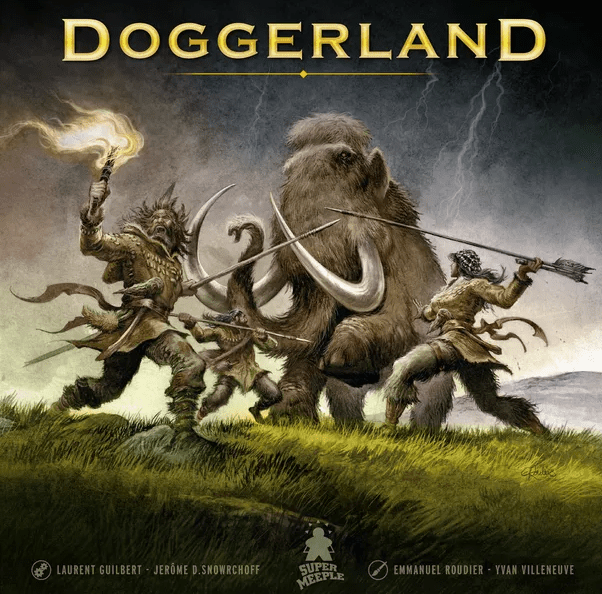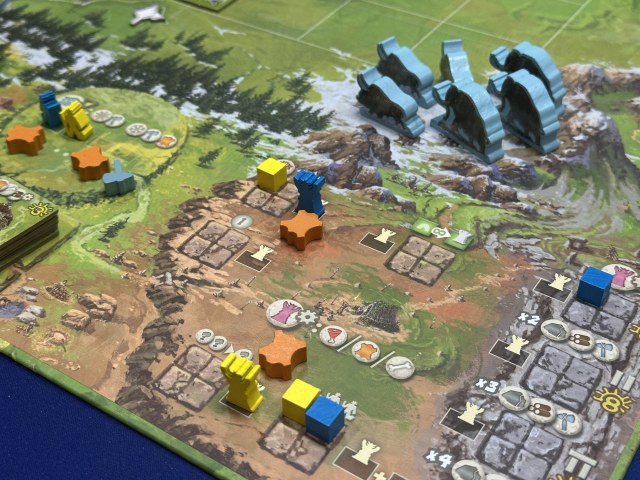I consider myself a history buff… but I’d never heard of the geographic area known as Doggerland before I received a review copy of the new board game named – appropriately – Doggerland. For those of you with the same level of ignorance as myself, the Wikipedia article is helpful (but pretty intense – it gets one of those “This article may be too technical for most readers to understand” warnings at the top of the page.)
Essentially, Doggerland refers to a section of now-submerged land that connected the east coast of Great Britain, the Netherlands, the western coast of Germany, and the Danish peninsula of Jutland.
In the game designed by Laurent Guilbert and Jérôme Daniel Snowrchoff, you are a prehistoric tribe, working to survive (and possibly thrive) in this harsh environment. As you and your tribe (including your chief and shaman) collect resources, hunt game, build shelters, and leave your mark on the landscape (via megaliths & cave paintings), you are laying the groundwork for your success.
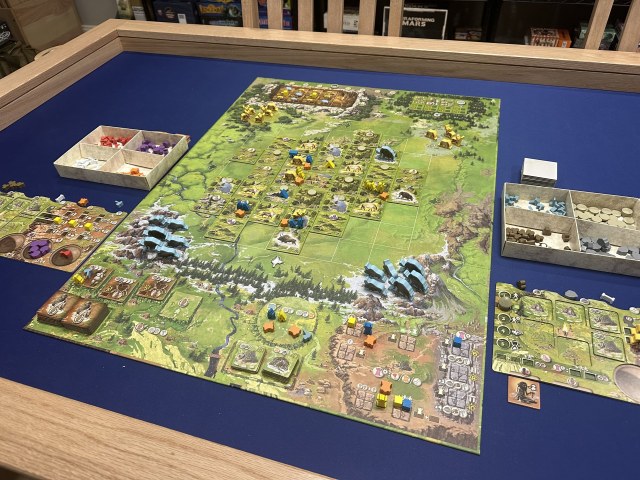
How Does the Game Work?
I know, I know… it sounds suspiciously like the classic Euro game, Stone Age. While it shares thematic elements (prehistoric tribal life) and mechanisms (collecting food & other resources), Doggerland contains no dice (whoa!) and has a much less abstracted process of utilizing the various stuff you’re hoarding. Additionally, the play space “expands” as you send tribe members out to gather and hunt – and “contracts” as spaces are exhausted when you’ve used up all the resources available there.
The game lasts 8 rounds: four hot seasons alternating with four cold seasons. (There is a variant in the rulebook for a 6 round game.) Each round has five phases, some of which can be completed simultaneously.
- Phase 1 – Program Actions
- Essentially a worker placement phase, players in turn send one or more tribe members to accomplish various tasks. I’ll go into more detail about these potential actions in the next section.
- Some actions have a cost when you program them – your tribe members might need to spend a tool or fur resource.
- Phase 2 – Reveal Terrain Tiles
- Each empty space next to a tile with tribe members, a megalith, or a tribal encampment receives a new random tile.
- Phase 3 – Resolve Actions
- Players can resolve the actions they’ve programmed. (This can be done simultaneously or in turn order.)
- An action must be fully resolved before resolving the next action.
- Phase 4 – Animals Migrate
- Animals who were not hunted in Phase 3 will migrate across the map.
- Phase 5 – End of Round
- Players feed their tribe members, check completion of objectives, advance the round tracker, add new animals to the board, flip a new fresco tile and refill the handicraft area, and finally move their village/tribal encampment.
- The first player hut then passes clockwise unless someone sent their shaman to become the first player as an action.
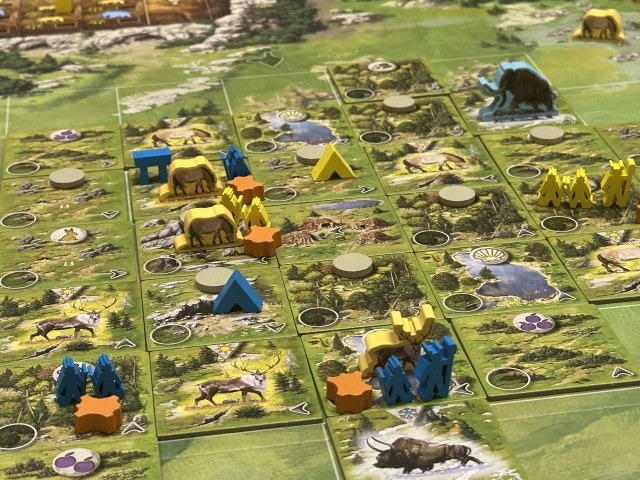
The Life of a Prehistoric Tribesman
The heart of Doggerland is the actions that are programmed and performed by each tribe. There are 8 different actions available – with the last choice (using your village shaman) having multiple once per game options.
- Construct a Habitat
- A single tribe member can build either a simple or prestigious habitat.
- Simple habitats can house 3 tribe members.
- Prestigious habitats only house a single tribe member, but are worth more points at the end of the game.
- Tribes begin with two simple habitats.
- There are four empty spaces on your player board for new habitats… and you can build over the original two habitats as well.
- Cost to program: a tool in hot season; a tool & a fur in cold season
- Cost to build: stone & wood for a simple habitat; fur, bone, & wood for a prestigious habitat
- A single tribe member can build either a simple or prestigious habitat.
- Create a Handicraft
- A single tribe member can create a necklace or statue.
- Cost to program: a tool
- Cost to build: depends on the individual item
- Reproduce
- Two tribe members can be assigned to reproduce.
- The newborn comes into play during Phase 3 but does not need to be fed this season.
- Gather Resources
- You can organize an expedition to collect resources: wood, stone, or fruit.
- You can also hunt gather food:
- Shellfish (which produce fruit & bone)
- Small game (which produce meat & fur)
- Cost to program: a fur in cold season
- Hunt Large Game
- You can organize an expedition to hunt large game
- Depending on the animal you are hunting, this will require a minimum number of tribe members as well as sufficient tools to finish the job.
- Cost to program: a tool in hot season; a tool & a fur in cold season
- You can organize an expedition to hunt large game
- Paint the Fresco
- You can send a tribe member to paint the fresco if you have a large animal “kill” in your collective memory.
- Cost to program: a tool in hot season; a tool & a fur in cold season
- Improve Your Abilities
- You can send tribe members to increase your abilities in three areas:
- How far your tribe members can move
- How much each tribe member can carry
- How many tools you can make + making tools
- Cost to build: depends on what you are increasing and at what level
- You can pay to increase your tool making ability and make tools in the same action – but you must pay both costs
- You can send tribe members to increase your abilities in three areas:
- Use the Shaman
- Shamans have a variety of special magic they can do for you – but they can only do each one once per game.
- Paint the same animal twice on the Fresco
- The tribe must have two identical animals in their collective memory.
- Become the next first player
- Take a long trip (reserving a distant tile for your tribe the next turn, no matter how far away it is)
- Invoke the birth of twins (getting two newborns in a single turn)
- Trade with a distant tribe (resource exchange at a 2:1 rate)
- Erect a megalith
- Paint the same animal twice on the Fresco
- Cost to build: depends on which shaman action is being taken
- Shamans have a variety of special magic they can do for you – but they can only do each one once per game.
I’ll be the first to acknowledge that while Doggerland hasn’t reached Civolution’s pinnacle of action overload, it is a lot of stuff to wrap your head around the first time you play. To the designer’s credit, though, the action all make sense from a thematic perspective – thus making it easier to pick between them.
I’ve avoided trying to explain the intricacies of harvesting resources (either by gathering or by hunting large game) and transporting them back to your camp… while they all make sense, they are easier to understand when you have a player aid card in front of you. (Note:your average prehistoric tribe member was unlikely to have access to those nifty big blue Ikea bags.) It’s also important to note that resource areas are depleted and marked with exhaustion markers, forcing tribes to forage over wider areas.
If you can’t pay for something, you can take a scarcity tile instead for each missing resource… which is minus 2 points per tile at the end of the game. (It’s harsh.)
It’s Good To Be The Chief
One of your tribe members is your chief – who receives certain benefits when they are assigned to particular actions. They spend one less wood to build habitats, they can make handicrafts even if you’ve already assigned a tribe member there, they improve the quality of hunting and gathering expeditions (though they can’t carry more than any other tribe member), and they can paint a second fresco even if you’ve already assigned a tribe member there.
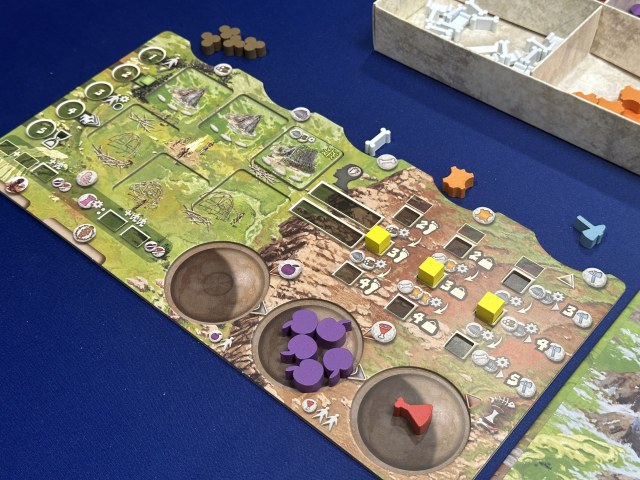
The End of a Season
One thing Doggerland shares in common with many games (Stone Age, Agricola, Roll Through the Ages, Little Town, etc.) is the need to feed your people. A fruit resource can feed a single person; meat resources can feed two tribe members.
However, food doesn’t last forever. Any uneaten food drops one “food bowl” lower on your player board – eventually spoiling. (And meat spoils quicker than fruit, of course.)
Tribes can also move their encampment up to their movement allowance – giving them a new base of operations in order to leave behind exhausted hunting & gathering areas.
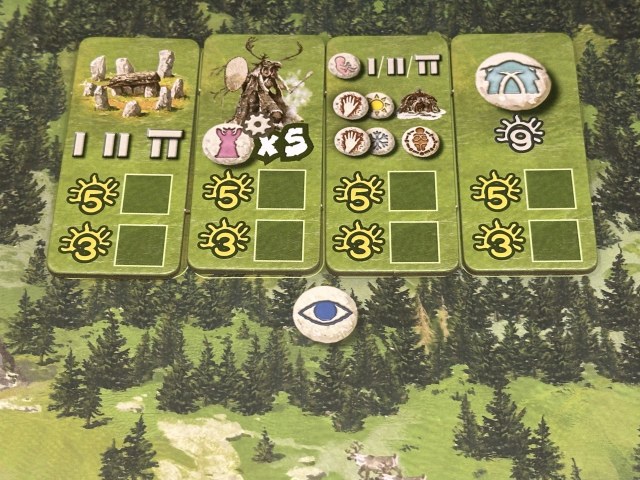
The End of the Game
At the end of the 8th season, players score points in the following manner:
- 1 point for every tribe member
- Habitats
- 3 points for each prestigious habitat
- 1 point for each simple habitat
- Earn the appropriate (6/8/10) points for each megalith your shaman built
- Earn points for each objective tile with your cube on it
- 5 points for the first tribe to complete the objective
- 3 points for all other tribes completing the objective
- Earn points for each animal painted on the fresco (1/2/3/4)
- Bonus fresco points for most paintings in a row on the fresco (4/2)
- Deduct every scarcity tile you had to take
The tribe with the most points wins.
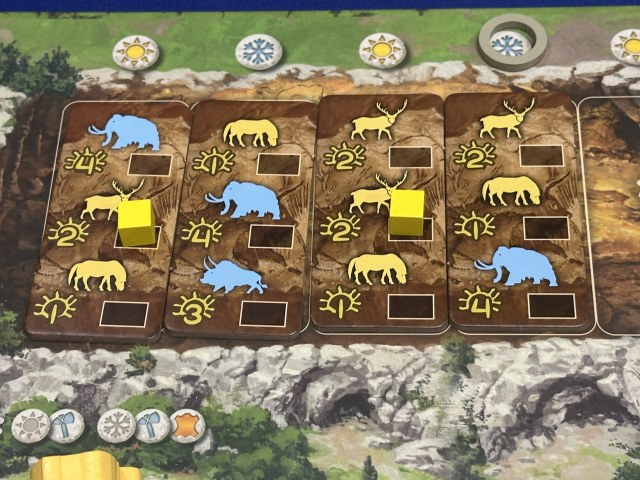
Some Thoughts About Doggerland
I’ll start out by commending Super Meeple for the excellent production of the game: the wooden bits are great, the player boards are helpful and clear, and the rulebook is complete and copiously filled with examples to clarify situations. I’d have liked a more extensive player aid card – the one they provide is good but really needed to include more information. I’m also aware that some of the rules are tucked away on pages I wouldn’t have anticipated – but this isn’t one of those games where you need to constantly consult BGG during your first play to try & figure out what the heck is going on.
There is definite potential for hosage in the worker placement/programming actions portion of the game – particularly since some of the actions come with a programming cost that you don’t recoup if you are unable to perform the action. As resources begin to dwindle near the end of the game, avoiding taking too many scarcity tiles becomes paramount to avoid tanking your score. Doggerland is decidedly NOT multi-player solitaire.
At the same time, much of the game you are simply working your own plan – and the sequencing of those actions is sometimes pretty tricky. (That includes the order in which you program them AND the order in which you resolve them.) That means that the game occasionally slows down as one or more players have to run the possible scenarios in their head before committing to things on the board.
The solo mode has a separate section of the rulebook (marked by have a different colored background for the pages – a much appreciated feature). I found my single game of the solo mode pretty tough sledding – the mixture of objectives was too much for my poor little tribe to bear.
Overall, this is a relatively straightforward medium weight worker placement game with very little randomness and strong ties between theme and gameplay. (The migration of large animals and the tribes subsequent migration to keep them in movement range is a great example of this.) I’d be a bit cautious about playing with AP (analysis paralysis) players due to the sequencing issues, but I wouldn’t let that stop you from playing the game itself.

